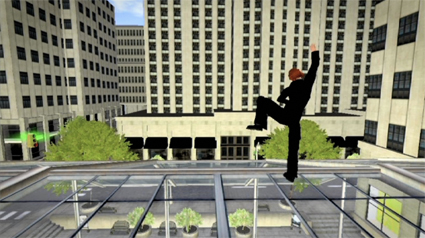dance, animation & other realities
realtime: physical tv, entanglement theory

Entanglement Theory
courtesy Physical TV
Entanglement Theory
RICHARD JAMES ALLEN AND KAREN PEARLMAN (PHYSICAL TV) AND COLLABORATORS HAVE INVESTED MUCH IN THEIR 10-MINUTE FILM, ENTANGLEMENT THEORY, MELDING PHYSICAL AND VIRTUAL PERFORMANCE, CONNECTING A DANCING MAN (ALLEN) AND HIS SECOND LIFE AVATAR ACROSS IMPONDERABLE TIME-SPACE DISTANCES. SPEAKING WITH ALLEN AND PEARLMAN REVEALS JUST HOW MUCH THINKING AND WORK HAS GONE INTO THE FILM AND WHAT THEY HOPE THEIR ALREADY GLOBAL AUDIENCES ARE EXPERIENCING.
Borrowing directly from Quantum Physics’ Entanglement Theory, dancer and avatar in the film are like bound particles—however far apart, a change in one results immediately in a change in the other. In the film, the characters’ discrete worlds are parallel ones until, in the end, their realities overlap—as Allen dances on a timber bridge over a pond, transparent figures glide about him and, finally, now spirit-like himself, he enters the Second Life city of his avatar and they dance high amidst its buildings.
Allen is attracted to Entanglement Theory’s resonances with Vedic philosophy and with a dualism that perpetually resolves into the oneness of together-apart. This is not made literal in the film; there’s no explanatory content. You simply enjoy a fantasy that might translate into something more than a man who dances through intimate, inner city streets (while his avatar inhabits a hard, Second Life cityscape), falls asleep in a humble room (his doppelganger lounges in luxury before a blazing log fire), dozes on a park bench and then dances with his other as their worlds overlap. But Allen hopes you might feel a more heightened form of enjoyment.
Thinking, meditation and yoga are the usual means of apprehending or entering transcendent states but, says Allen, in the film they’re to be found in dance and dream. As well as defying gravity, dance can be ecstatically transcendent or subtly contemplative (Allen, like a Hollywood musical character dances past pedestrians, breaking with the everyday), while sleep opens the door to the avatar’s world. For Allen, the state to aspire to is Turiya, which in Hindu philosophy is beyond waking consciousness, dreaming and deep sleep, and beyond time and space. He and Pearlman have therefore structured the film around waking, sleeping, dreaming and Turiya.
Research for the film began with Pearlman and Allen working with Gary Hayes (“a Second Life genius,” says Allen) of MUVEDesign at Critical Path in January 2009 mixing real and Second Life through improvisation and developing “intermedia choreographic ideas.” Some of the outcomes were performed live with screen projections in Do Avatars Dream of Human Sleep? and then work began on Entanglement Theory.
Both makers are now intrigued by how enthusiastically their film has been taken up by audiences and programmers, including ABC TV, and suspect that viewers intuitively pick up on its deeper resonances. With almost 20 screenings this year, Allen says that the take-up is the fastest they’ve had for one of their films. Entanglement Theory has been shown in dance film and other festivals in São Paulo, Ghent, Michigan, Bergamo, Helsinki, Fort Worth, Tulsa, Trieste, Naples, Oklahoma, Johannesburg and at the Dungog Film Festival (NSW). It will screen at EDIT 2010 International Dance Film Festival in Budapest in October and at the Inshadow International Festival of Video, Performance and Technologies in Lisbon in December.
When the film appeared in the Animation Event of the Dance on Camera Festival in New York in January this year the New York Times reviewer wrote of the program: “It’s striking here that almost all of these shorts combine cartoons with live-action photography. In the best of these, Entanglement Theory…this mixture gives a new vitality to the dream states that preoccupy so many of the current crop of Dance on Camera filmmakers” (NYT, Jan 30).
While there’s a long history of mixing live dance with animation (peaking in 50s MGM musicals and revived in the digital era), Physical TV’s exploration of the possibilities of working with Second Life animation reveals the increasing range of technical means available for creative use by (and within the reach of) artists. While the Second Life aesthetic will never be to everyone’s taste and avatars cannot as yet move as subtly as their human counterparts, there are in Entanglement Theory moments of supple elegance and in the overall oscillation between worlds a fluidity of movement and editing that makes for a seductive reverie. See for yourself when it screens on ABC TV.
Entanglement Theory will be shown on ABC2, October 31 at 8.20pm and ABC 1 on November 7 at 4.20pm.
Entanglement Theory, choreographer, director Richard James Allen, Second Life artist, animateur, machinimatographer Gary Hayes, editor, dramaturg/writer Karen Pearlman, supervising sound editor Andrew Plain, composer Fiona Hill, producer Physical TV.
RealTime issue #99 Oct-Nov 2010 pg. 16






